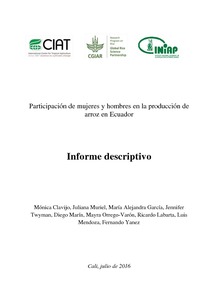Mission
To reduce hunger and poverty, and improve human nutrition in the tropics through research aimed at increasing the eco-efficiency of agriculture.
People
CIAT’s staff includes about 200 scientists. Supported by a wide array of donors, the Center collaborates with hundreds of partners to conduct high-quality research and translate the results into development impact. A Board of Trustees provides oversight of CIAT’s research and financial management.
Values
- Shared organizational ethic
- We respect each other, our partners, and the people who benefit from our work. We act with honesty, integrity, transparency, and environmental responsibility in all of our joint endeavors.
- Learning through partnerships
- We work efficiently and pragmatically together and with partners. Considering our diversity to be a key asset, we adapt readily to change and strive to improve our performance through continuous learning.
- Innovation for impact
- We develop innovative solutions to important challenges in tropical agriculture, resulting in major benefits for the people who support, participate in, and profit from our work.
Members:
Resources
Displaying 211 - 215 of 958Participación de mujeres y hombres en la producción de arroz en Ecuador
Crop residue allocation to livestock feed, soil improvement and other uses along a productivity gradient in Eastern Africa
Crop residues are a key livelihood resource in smallholder mixed crop-livestock systems in Sub-Saharan Africa. With expansion of arable land and resultant decline in grazing resources, crop residues are becoming an increasingly important component of livestock feeds. This demand for livestock feeds has implications for the long-term sustainability of such systems since failure to return biomass to soils has implications for soil quality and the capacity of soils to support long-term productivity.
The yield gap: closing the gap by widening the approach
The yield gap has arisen again as a focus for agricultural research to ensure food security and economic growth for farmers around the world. To examine this renewed interest, we carried out a review of key literature in the field of yield gap analysis to identify important gaps in research and analysis. In so doing, both the complexities in yield gap studies emerged along with some significant omissions. Much of the literature and research on the yield gap has been framed by larger concerns and initiatives to raise agricultural productivity.
Indirect Impact Assessment of the road segment San Juan Nepomuceno-Ruta 6 in Paraguay
This study analyzes the past, current and potential future deforestation resulting from the improvement of the road segment between San Juan Nepomuceno and the 6th route (PR-L1080) in Southeastern Paraguay. For the purpose of the analysis, the study used satellite images to detect deviations from the usual pattern of vegetation and thus identify anthropogenic change. The deforestation baseline in the study area was defined using Landsat imagery from 1987 to 2014.
Indirect Impact Assessment of the road segment San Juan Nepomuceno-Ruta 6 in Paraguay
This study analyzes the past, current and potential future deforestation resulting from the improvement of the road segment between San Juan Nepomuceno and the 6th route (PR-L1080) in Southeastern Paraguay. For the purpose of the analysis, the study used satellite images to detect deviations from the usual pattern of vegetation and thus identify anthropogenic change. The deforestation baseline in the study area was defined using Landsat imagery from 1987 to 2014.





